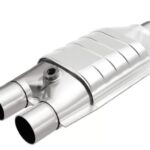The OBD-II fault code P0128 signals a problem within your vehicle’s engine cooling system, specifically related to how quickly your engine reaches its optimal operating temperature. As an essential aspect of vehicle performance and emissions control, understanding and addressing P0128 promptly is crucial. This guide, brought to you by the automotive experts at autelfrance.com, will delve into the intricacies of the P0128 code, helping you understand its causes, symptoms, diagnosis, and how to rectify it, ensuring your vehicle runs efficiently and cleanly.
Understanding OBD-II Code P0128: Coolant Thermostat Below Regulating Temperature
At its core, OBD-II code P0128 indicates that your vehicle’s Powertrain Control Module (PCM) has detected that the engine coolant temperature has not reached the required level within a specified timeframe after engine startup. Modern vehicles are designed to operate most efficiently and with minimal emissions output when the engine reaches a specific temperature range, typically between 160-170 degrees Fahrenheit (71-77 degrees Celsius). This warm-up period is usually expected to occur within about 15 minutes of starting the engine.
If the PCM determines that the coolant temperature is lagging behind this expected warm-up curve, or if the temperature fluctuates erratically around the target range, it recognizes that it cannot effectively manage fuel delivery and emissions. This is when the P0128 trouble code is triggered, and the “Check Engine Light” illuminates on your dashboard.
Recognizing the Symptoms of a P0128 Code
While a P0128 code might sometimes occur without immediately noticeable driving issues, there are several symptoms that can indicate this problem:
- Check Engine Light Illumination: This is the most direct indicator. The malfunction indicator lamp (MIL), or “Check Engine Light,” will turn on to alert you to a detected issue.
- Reduced Fuel Economy: An engine that runs cooler than intended often operates with a richer fuel mixture to compensate. This can lead to a noticeable decrease in your vehicle’s miles per gallon.
- Hesitation in Shifting to Higher Gears: Some vehicles may not shift into their highest gear, especially at highway speeds, if the engine isn’t at the correct operating temperature. This is a protective measure by the PCM to prevent potential damage and ensure optimal performance under suboptimal temperature conditions.
- No Noticeable Symptoms (Less Common): In some instances, particularly in warmer climates or during shorter trips, you might not observe any obvious drivability problems despite the P0128 code being present. However, the underlying issue still needs addressing to prevent long-term complications.
Common Culprits Behind a P0128 Code
Several components within your vehicle’s cooling and engine management systems can contribute to a P0128 code. Here are the most frequent causes:
- Defective Engine Thermostat: This is the most common cause. The thermostat’s job is to regulate coolant flow and engine temperature. If it’s stuck open or opening too soon, it will allow coolant to circulate prematurely, preventing the engine from warming up quickly enough.
- Faulty Engine Coolant Temperature (ECT) Sensor: The ECT sensor provides temperature readings to the PCM. If this sensor is inaccurate or failing, it can send incorrect data, leading the PCM to mistakenly believe the engine is not warming up properly and trigger the P0128 code.
- Defective Intake Air Temperature (IAT) Sensor: While less direct, an inaccurate IAT sensor reading can also indirectly affect the PCM’s temperature calculations and contribute to a P0128 code in some vehicle models.
- Cooling System Issues: Problems like a failing water pump (reduced coolant circulation), air pockets in the cooling system, or even a clogged radiator can hinder proper warm-up and trigger the code.
- Low Engine Coolant Level: Insufficient coolant in the system reduces its capacity to retain and distribute heat effectively, potentially slowing down the warm-up process.
- Contaminated or Old Engine Coolant: Dirty or degraded coolant loses its heat transfer efficiency, which can impact the engine’s ability to reach operating temperature quickly.
- Malfunctioning Engine Cooling Fan(s): If the electric cooling fan is stuck in the “on” position or the mechanical fan clutch is faulty, the constant airflow can overcool the engine, especially in colder weather, preventing it from reaching optimal temperature.
 Shop Image
Shop Image
Diagnosing a P0128 Code: A Step-by-Step Approach
Diagnosing a P0128 code requires a systematic approach to pinpoint the root cause. Here’s a step-by-step guide for effective diagnosis:
-
Record Freeze Frame Data: Use an OBD-II scanner to retrieve the freeze frame data associated with the P0128 code. This snapshot of sensor readings at the moment the code was set can provide valuable clues. Pay close attention to parameters like MPH, RPM, engine load, throttle position, ECT sensor reading, and IAT sensor reading. This data helps understand the conditions under which the code was triggered (e.g., highway driving vs. city driving).
-
Monitor Live Data Stream: Connect your scanner and access the live data stream for engine sensors, particularly the ECT and IAT sensors. Start the engine (with the heater off initially) and observe how the coolant temperature reading changes over time.
-
Evaluate Warm-up Time: Monitor if the coolant temperature reaches the 160-170°F (71-77°C) range within approximately 15 minutes. If it doesn’t:
- Simulate Load: With the vehicle safely parked and the parking brake engaged, put the vehicle in “Drive” (or equivalent for automatic transmissions), apply the brakes, and gently apply the throttle for a couple of minutes. Observe if the coolant temperature starts to rise more effectively under a simulated load. If it does reach the proper range under load, the thermostat is highly likely to be the problem.
-
Test Thermostat Functionality: If the engine still struggles to reach operating temperature:
- Increase RPM and Turn on Heater: With the vehicle in “Park,” increase the engine RPM to around 2000 and turn the heater to its maximum setting. Monitor the coolant temperature. If the temperature now drops below the required range when the heater is on and RPM is raised, it strongly indicates a faulty thermostat that is stuck open or opening too early.
-
Check Cooling Fan Operation: Inspect the engine cooling fan(s). Ensure they are not running constantly when they shouldn’t be. A fan stuck “on” will overcool the engine, especially in cooler ambient temperatures. Check for a faulty fan clutch (mechanical fans) or a stuck relay/faulty sensor (electric fans).
-
Verify IAT Sensor Readings: Compare the IAT sensor reading with the ambient air temperature and the under-hood temperature. After the engine is warmed up, the IAT reading should typically be around 10-20°F (5-10°C) lower than the ECT reading. When the engine is cold, the IAT and ECT readings should be very close. Significant discrepancies can suggest an IAT sensor issue.
-
Inspect Coolant Level and Condition: Check the coolant level in the reservoir and radiator (when cold and safe to open). Low coolant can impede warm-up. Also, examine the coolant’s condition. If it’s dirty, rusty, or sludgy, it may be affecting heat transfer.
P0128 and its Impact on Emissions and Fuel Economy
Leaving a P0128 code unaddressed can have negative consequences:
-
Increased Emissions: When the engine runs too cold, it operates outside its optimal combustion efficiency range. This leads to increased levels of harmful emissions, particularly:
- Hydrocarbons (HCs): Unburned fuel vapors that contribute to smog and air pollution.
- Carbon Monoxide (CO): A poisonous, odorless gas resulting from incomplete combustion.
-
Reduced Fuel Efficiency: As mentioned earlier, the PCM may enrich the fuel mixture to compensate for a cold-running engine. This results in burning more fuel than necessary, leading to decreased fuel economy and higher running costs.
Common Misdiagnoses to Avoid with P0128
It’s essential to avoid common misdiagnoses when troubleshooting a P0128 code. Technicians sometimes mistakenly focus on:
- Engine Cooling Fan Issues Only: While a stuck-on fan can cause P0128, it’s not the only cause. Don’t assume the fan is the sole problem without thoroughly checking the thermostat and ECT sensor.
- Oxygen Sensor Problems: Because emissions are affected, some might jump to oxygen sensor issues. However, P0128 is primarily a coolant temperature related code.
- Internal Engine Problems: In rare cases, severe internal engine issues could theoretically impact warm-up, but thermostat and sensor problems are far more likely with P0128.
- ECT Sensor Problems Only: While a faulty ECT sensor is a possible cause, the thermostat is statistically a more frequent culprit.
Resolving P0128 and Restoring Engine Efficiency
Addressing a P0128 code typically involves replacing the faulty component. In most cases, replacing the engine thermostat is the most effective solution. If the thermostat is confirmed to be functioning correctly, further investigation into the ECT sensor, cooling system, and fan operation is necessary.
By systematically diagnosing and addressing the root cause of the P0128 code, you can restore your vehicle’s engine to its optimal operating temperature, ensuring efficient fuel consumption, reduced emissions, and overall improved performance. If you are not comfortable performing these diagnostic steps or repairs yourself, it is always recommended to consult a qualified automotive technician to ensure accurate diagnosis and repair.

